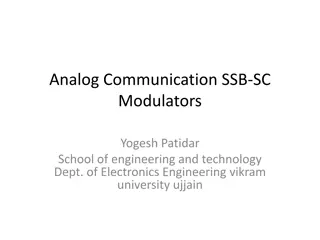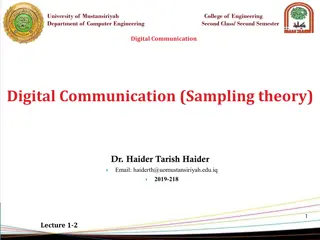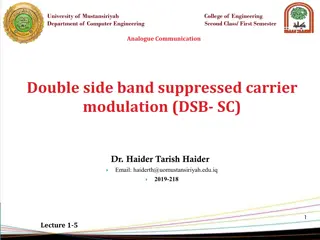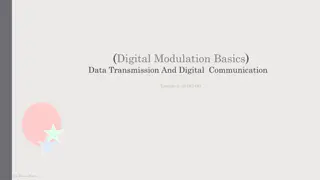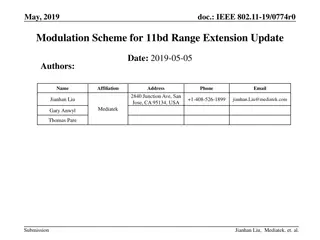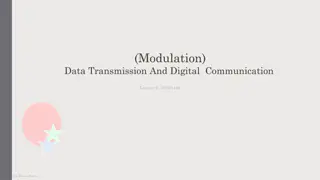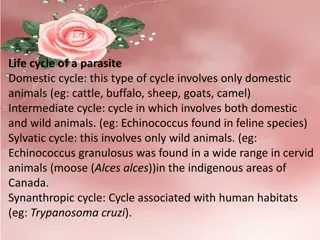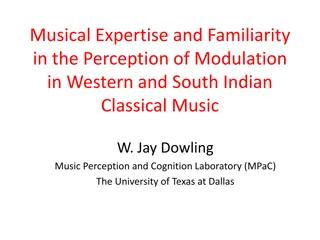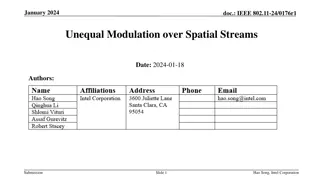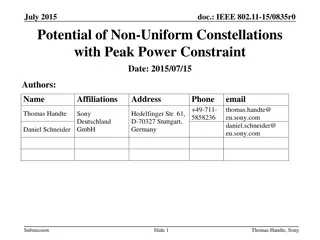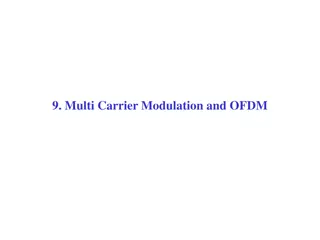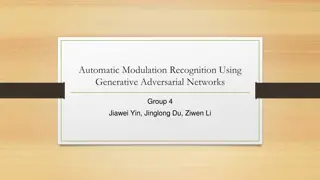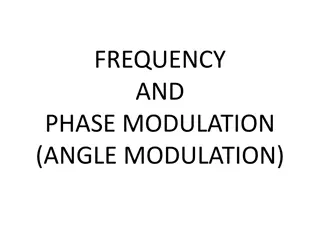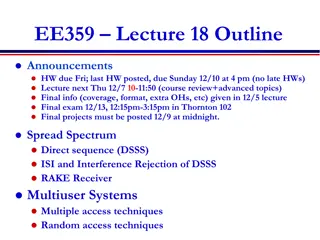HOST MODULATION
Host modulation in periodontal disease involves altering the host's responses to bacterial challenges to manage inflammation and protect periodontal tissues. Techniques such as inhibition of matrix metalloproteinases and modulation of arachidonic acid metabolites play crucial roles in regulating immune and inflammatory responses.
Download Presentation

Please find below an Image/Link to download the presentation.
The content on the website is provided AS IS for your information and personal use only. It may not be sold, licensed, or shared on other websites without obtaining consent from the author.If you encounter any issues during the download, it is possible that the publisher has removed the file from their server.
You are allowed to download the files provided on this website for personal or commercial use, subject to the condition that they are used lawfully. All files are the property of their respective owners.
The content on the website is provided AS IS for your information and personal use only. It may not be sold, licensed, or shared on other websites without obtaining consent from the author.
E N D
Presentation Transcript
HOST MODULATION PRESENTED BY: PRIYANJALI JADHAV
INDEX Hormone Replacement Regulation of immune and inflammatory responses Other host modulatory agents Host modulation in diabetes Combination of host response modulators Future of host response modulation Conclusion Introduction Classification Inhibition of arachidonic acid Metabolism Bisphosphonates Matrix metalloproteinases Inhibition of MMPs CMTs and SDD SDD in smokers
INTRODUCTION Host can be defined as "the orgasm from which a parasite obtains its nourishment", Modulation is defined as "the alteration of function or status of something in response to a stimulus" or an altered chemical or physical environment. The concept of host modulation was first introduced to dentistry by williams et al in 1990 and Golub et all in 1992.
INTRODUCTION The immune inflamatory response against bacterial plaque can thus be viewed as a two edged sword. Excessive quantities of destructive enzymes and inflammatory mediators and inflammatory response of bacterial challenge. Periodontal disease is characterized by high concentration of MMPs, cytokines and prostanoids in the periodontal tissues, whereas periodontal health is characterized by the opposite.
PATHOGENESIS OF HUMAN PERIODONTITIS Host modulatory therapy can be used to interrupt the positive feedback loops(PGE2, Interlukins, TNF-alpha and MMPs) The inflammation extends apically and osteoclats themselves are targets for host modulation. The elevation in the pro inflammatory or destructive mediators in response to bacterial challenge are counter balanced by elevations in anti-inflammatory or protective mediators such as cytokines IL-44 and IL-10, as well as other mediators such as IL-ra and Tisuue Inhibitors of metalloproteinases.
CLASSIFICATION Various HMT have been developed or proposed to block pathways responsible for periodontal tissue breakdown. 1. Inhibition of matrix metalloproteinases (MMPs): Through chemically modified tetracyclines(CMTs) 2. Inhibition of archidonic acid metabolites: Through NSAIDs COX 1 inhibitors, indomethacin , naproxen,flurbiprofen COX 2 inhibitors, rofecoxib COX and LOX inhibitors, troclosan , topical ketoprofen LOX inhibitors: lipoxins
CLASSIFICATION 1. Modulation of bone metabolism: Bisphosphonates Hormone replacement therapy(HRT) 2. Regulation of immune and inflammatory responses: Suppressing proinflammatory cytokines(IL 1 and TNF- alpha receptor antagonists) Nitric oxide inhibition Generation of protective antibodies through vaccines Infusion/supplementary anti inflammatory cytokines IL 4 and IL 10.
INHIBITION OF ARACHIDONIC ACID METABOLISM: NSAIDs Lipoxins Omega-3 fatty acids Triclosan
INHIBITION OF ARACHIDONIC ACID METABOLISM: NSAIDs : Nonsteroidal anti-inflammatory drugs inhibit the formation of prostaglandins, including prostaglandin E2 The ability of NSAIDs drugs to block prostaglandin E2 production, thereby reducing inflammation and inhibiting osteoclast activity, has been investigated in patients with periodontal disease. Drugs like flurbiprofen, indomethacin, naproxen, administered daily upto 3 years, showed significantly rate of alveolar bone as compared to placebo.
COX-1 AND COX-2 The enzymes cyclo-oxygenase, which metabolizes archadonic acid, exists in two functionally distinct isoforms: Cyclo-Oxygenase 1(which is constitutively expressed and has antithrombogenic and cytoprotective functions) and Cyclo-Oxygenase 2 (which is induced after stimulation with various cytokines, growth factors and lipopolysaccharide).
COX-1 AND COX-2 Inhibition of Cyclo-Oxygenase 1 Results in the majority of unwanted effects associated with non-steroidal anti- inflammatory drug use, such as gastrointestinal ulceration and impaired hemostasis. Induction of Cyclo-Oxygenase 2 Results in the production of elevated quantities of prostaglandins, and therefore inhibition of Cyclo-Oxygenase 2 by selective inhibitors. These include NS-398, nimesulide, etodolac, meloxicam, celecoxib, rofecoxib. Etoricoxib and lumiracoxib.
LOCALLY ADMINISTERED AGENTS NSAIDS NSAIDs that have been evaluated for topical administration includes ketorolac tromethamine rinse and S ketoprofen dentifrice. Li et al.(1996) presented preclinical data on a topical ketoprofen cream(1%) and its effects on spontaneous and ligature-induced periodontitis in the rhesus monkeys. The investigators did not observe a clinical improvement in gingival inflammation, they did note significant depression in prostaglandin E2 and leukotriene B4 levels in gingival crevicular fluid and in ketoprofen-treated animals versus placebo animals.
DISADVANTAGES OF NSAIDS Once patient cease taking non-steroidal ant-inflammatory drugs, a return to or even acceleration of the rate of bone loss seen prior to drug therapy occurs sometimes referred to as a rebound effect. Non-steroidal anti-inflammatory drugs have been extensively reviewed as potential host response modulators for the treatment of periodontal disease.
ANTI-INFLAMMATION VERSUS RESOLUTION: Cyclo-oxygenase(COX)- inhibitors prevent prostaglandin biosynthesis and are effective anti-inflammatory mediators; however, they prolong the time to resolve and thus extend tissue inflammation. But, for pro-resolving, it must be an agonist to resolution via targetingcell types and events critical for the tissue to return to homeostasis.
MECHANISM OF ACTION OF OMEGA-3 DERIVATIVES Lipid-derived mediators are well positioned to play key role as signalling molecules in inflammation because they are small molecules, local-acting, rapidly generated and locally inactivated. Pro-inflammatory prostaglandins and leukotriene B4 (LTB4) control local blood flow, vascular dilation, and permeability changes needed at the site for leukocyte adhesion, diapedesis and recruitment.
MECHANISM OF ACTION OF OMEGA- 3 DERIVATIVES The essential roles of omega-3 PUFAs in health were evident in 1929. Omega-3 PUFAs are widely held to act via several possible mechanisms such as preventing conversion of arachidonate to proinflammatory eicosanoids or serving as an alternative substrate producing less-potent products. Pre-resolving lipid mediators are a novel genus of endogenous chemical mediators, including Lipoxin(LXs), which are involved in acute inflammation.
MECHANISM OF ACTION OF OMEGA-3 DERIVATIVES: Lipid derived mediators are well positioned to play key role as signalling molecules in inflammation because they are small molecules, local-acting, rapidly generated, and locally inactivated. Pro-inflammatory prostaglandins and leukotriene B4(LTB4) control local blood flow, vascular dilation and permeability changes needed at the site for leukocyte adhesion, diapedesis and recruitment.
MECHANISM OF ACTION OF OMEGA- 3 DERIVATIVES: The essential roles of omega-3 PUFAs in health were evident in 1929. Omega-3 PUFAs are widely held to act via several possible mechanisms, such as preventing conversion of arachidonate to pro-inflammatory eicosanoids or serving as an alternative substrate producing less-potent products. Pre-solving lipid mediators are a novel genus of endogenus chemical mediators, including lipoxin(LXs), resolvins(Rv) and protectins(PD) which are involved in acute inflammation.
MECHANISM OF ACTION OF OMEGA- 3 DERIVATIVES: They are actively biosynthesized in the resolution phase of acute inflammation and are potent agonists that control the duration and magnitude of inflammation. They are also potent chemo attractants, but act via a non-inflammatory mechanism: eg, lipoxins activate mononuclear cell infiltration without stimulating the release of pro- inflammatory chemokines or activation of pro-inflammatory gene pathways and products. They also stimulate the uptake of apoptotic polymorphonuclear neutrophils(PMNs) and activate endogenous antimicrobial defense mechanism as well as clearance on mucosal surfaces.
CHEMICAL MEDIATORS THAT HELP IN RESOLUTION: 1. Lipoxins 2. Aspirin-triggered lipoxins 3. Rv(Resolvins) 4. PD(Protectins)
LIPOXINS The lipoxin series are trihydroxy-tetraene contaning bioactive eicosanoids first isolated from human leukocytes. Lipoxins were the first mediators recognized to possess specific pro-resolution actions. When platelets adhere to PMNs, the platelet-PMN aggregates become a major intravascular source of LX that in turn halts further PMN diapedesis and recruitment.
LIPOXINS Mucosal and vascular cell-cell interactions:- The lipoxin biosynthetic circuit in cells enriched in 15-LO initiates the oxygeneration of AA by 15-LO to generate 15S-H (p) ETE(hydroperoxyeicosatetraenoic acid) transformed into an epoxytetraene intermediate generated by leukocyte 5-LO and specifically open to LXA4 and LXB4. Platelet-leukocyte interactions:- Platelets adhering to neutrophils can pick up and transform released 5-LO intermediate LTA4 and convert this to LXA4 and LXB4 by platelet 12-LO.
LIPOXINS Membrane phospholipid priming, stored precursors of 15-HETE:- Membrane precursors other than AA could be released and converted to bioactive substances. 15-HETE is stored in cell membrane containing lipids that are then charged and/or primed to produce lipoxins on activation of cells by releasing the stored 15-HETE that is taken up and transformed by the neighbouring leukocyte.
ASPIRIN-TRIGGERED LIPID MEDIATORS: Aspirin impacts lipoxin generation. Aspirin triggers the formation of the 15R-epimers of the lipoxins, specifically 15-epi-LXA4 and 15-epi-LXB4. These epimers carry their carbon- 15 alcohol group in the R configuration. The aspirin-triggered epimers of lipoxins are longer acting because they show reduced catalytic activity for enzyme inactivation.
RV AND PD: The bioactive local mediators, or autacoids that require enzymatic generation from the omega-3 essential fatty acid EPA resolving inflammatory exudates in vivo and carry potent stereoselective biological actions. They were termed Resolvins of the E(RvE) series derived from EPA. Those derived from DHA were termed Rv of the D series. The other family of bioactive chemical signals from DHA which specifically possess a conjugated triene double-bond system in their structures, are denoted protectins.
RVAND PD: The term Rv(resolution-phase interaction products) was firdt introduced to signify that these new structures were endogenous mediators, biosynthesized in the resolution phase of inflammatory exudates, possessing very potent anti-inflammatory and immunoregulatory actions. These actions include reducing neutrophil traffic, regulating cytokine and reactive oxygen species and lowering the magnitude of the response. The term neuroprotectin is applied to protectin that is generated in the neural tissues and has anti-inflammatory properties.
MATRIX METALLOPROTEINASES Family of zinc and calcium dependent endopeptidases secreted or released by a variety of host cells. The function at neutral pH and utilize the various constituents of extracellular matrix (eg. Collagen, gelatin, laminin, fibronectin & proteoglycan) as their substrate.
PRODUCTION OF MMPS Both resident gingival and periodontal ligament fibroblast produce collagenases that are thought to be involved in normal tissue turn over. Inflammatory cells such as neutrphils and macrophages produce MMPs, with neutrophils being the major source of collagenases & gelatinase in inflammatory diseases as periodontitis. Matrix metalloproteinases are not constitutively expressed in most tissues but are induced temporarily in response to exogenous signals such as cytokines, growth factors, cell matrix interactions and altered cell-cell contact.
CLASSIFICATION There are three major groups: 1. Specific collagenases 2. Gelatinases 3. Strome lysins 4. Others these include matrilysin, metalloelastase and recently cloned membrane bound metalloelastase. which include MMPs 7,12,14,15,16,17,24,25 Total 19types (MMP 1-26) with missing no.- 4,5,6,18,21,22,23
FUNCTIONS The main function of MMPs is to catalyze the breakdown of proteins in cell plasma membrane or within the extracellular matrix. In periodontal disease MMPs play key roles in the degradation of extracellulaer matrix, basement membrane and protective serpins as well as in the modification of cytokines action and activation of osteoclasts. The periodominant MMPs in periodontitis are MMP-8 and MMP-9.
SOURCE OF MMP'S Several periodontal pathogens e.g. porphyromonas gingivalis & actinobacillus actinomycetemcomitans produce MMPs, including collagenases, these proteinases are not considered to be the major destructive enzymes associated with disease progression. The major contribution of proteinases is host-derived.
INHIBITION OF MMPS: One of the most promising groups of potential HMTs is the chemically modified tetracyclines(CMTs). The CMTs are designed to be more potent inhibitors of anti-inflammatory mediators such as IL-10. Chemically modified tetracyclines are those which lack dimethylamino group on the 4th carbon atom.
INHIBITION OF MMPS: Mechanism of action of chemically modified tetracyclines: 1. Inhibits or chelates the calcium atoms that matrix metalloproteinase(MMPs) requires for their action. 2. Inhibit already active MMPs 3. Down regulate MMPs expression 4. Scavenges reactive oxygen species 5. Modulates the osteoclast functions
SUB ANTIMICROBIAL DOSE DOXYCYCLINE: SDD is currently the only FDA approved systemically administered HMT indicated specifically in the treatment of periodontitis. SDD is used as an adjunct to SRP and must not be used as a monotherapy.
NOVEL PROTEIN ANTAGONIST STRATERGIES IN THE TREATMENT OF PERIODONTAL DISEASES



